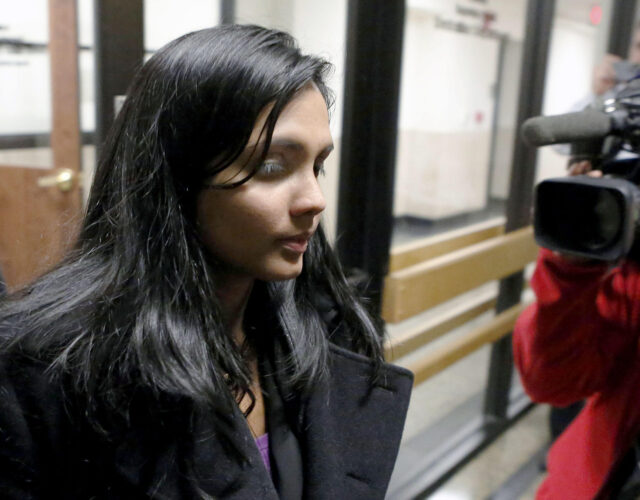Everyone was so thrilled for Annie Dookhan.
Dookhan did quality control for a vaccine maker near Boston, and no one in the lab worked harder. She was often the first to arrive in the morning and the last to leave at night. After hours she also had been working toward a graduate degree in chemistry through a part-time program at Harvard University. As she confessed to colleagues, she had dropped out of Harvard as an undergraduate years before for lack of money and switched to a state school.
So earning a graduate degree from Harvard felt particularly sweet—especially when she finished in just a year. To celebrate, the lab threw a party and hung a banner that read “Congratulations, Annie!”
The only thing was, none of it was true. Dookhan had never taken a class at Harvard, graduate or otherwise. Harvard didn’t even offer a part-time program in chemistry. Dookhan had made the whole thing up, a ploy for a promotion.
Unfortunately for her, the gambit failed, and the company declined to promote her. So, in 2003 she resigned and took a new job at a state lab near Boston that tested drugs for court cases.
By that point Dookhan, age 25, had already lied repeatedly about her qualifications and background. But she had always maintained integrity at the lab bench.
That was about to change.
Most people who cut corners do it out of laziness, but Annie Dookhan always worked hard.
She grew up in Trinidad, immigrating to Boston with her parents in the late 1980s. She later attended the prestigious Boston Latin School and ran track there; she even tried hurdling, despite standing 4 foot 11.
She received outstanding science grades at Boston Latin and later claimed she had graduated summa cum laude, even though the school didn’t grant such honors. She also told people, falsely, that her parents were both doctors. These petty lies continued in college and then at the vaccine company and state drug lab, where she invented titles for herself, such as FBI “special agent of operations.” Still, the lies to this point hadn’t harmed anyone. But eventually things took a criminal turn.
The state lab identified substances that police officers seized during drug arrests and raids. Since many drugs look alike—often white or off-white powders—the police would drop the evidence off at the lab so Dookhan and her colleagues could identify it, which they did through a series of tests.
The first round of tests, called presumptive tests, told the analysts the general class of drug they were dealing with. For example, one test involved adding formaldehyde and sulfuric acid to an unknown powder. If the sample turned reddish purple, it was an opiate; if it turned burnt orange, an amphetamine. Other chemicals might turn drugs green or blue or spur reactions that form distinctly shaped crystals.
After the presumptive test, a chemist ran a second, confirmatory test to narrow things down to a specific drug. The confirmatory test involved taking a bit of the unknown sample, dissolving it in a liquid, such as ethanol, methanol, or methylene chloride, and running the solution through a gas chromatography–mass spectrometry machine. If the first test had indicated, say, an opiate, the chemist would also run samples of known opiates (e.g., morphine, heroin, fentanyl) through the same analysis, as controls. The machine then printed graphs for each individual sample. By comparing the graph from the unknown sample to the graphs from the known samples, the chemist could identify the exact drug involved.
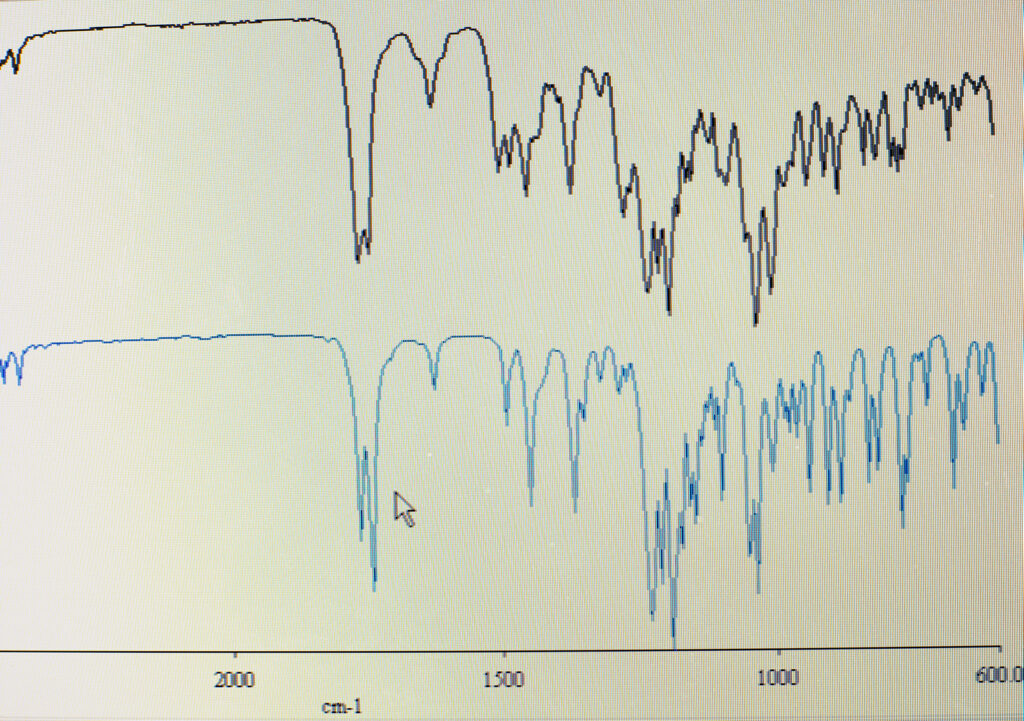
Like many drug labs, the Boston lab was drowning in samples. But with Dookhan’s arrival, things started looking up. She quickly distinguished herself as not only the hardest-working chemist but the speediest. In her first year, she churned through 9,239 drug samples—roughly three times what the other nine chemists tested on average. People started calling her “superwoman,” a compliment that left her glowing.
Privately, though, she was suffering. In 2004 she met an engineer from her native Trinidad and married him. Before long she was pregnant. But that first pregnancy ended in a miscarriage. (She later endured another.) The losses devastated her and put a strain on her marriage.
Rather than take time off to cope, Dookhan spent even more time at the lab. “I have chocolate and work,” she told her boss, “and that is my way of dealing with it.” The year after the first miscarriage, she raced through 11,232 samples, almost double the second-place chemist. Dookhan did eventually give birth, to a son with disabilities. The demands of motherhood slowed her pace, but she continued to lap her fellow chemists year after year.
Gradually, though, her coworkers grew suspicious of the superwoman in their midst. A colleague once caught Dookhan using an uncalibrated scale—a serious breach since the difference between, say, 13.99 grams and 14.00 grams of heroin or cocaine could have meant a difference of several years in prison at the time.
Colleagues also noticed that, despite all the tests Dookhan recorded doing, she never actually seemed to use her microscope. Nor did she seem to generate enough trash. One presumptive test, called a crystal test, involves mixing an unknown drug with a liquid on a glass slide. Crystals soon form, and different drugs make differently shaped crystals. Each test requires a clean glass slide to avoid contamination, so based on the number of tests run, chemists should be throwing away a certain number of slides per month. Dookhan wasn’t. Colleagues peeked into her discard bin and noticed how bare it looked.
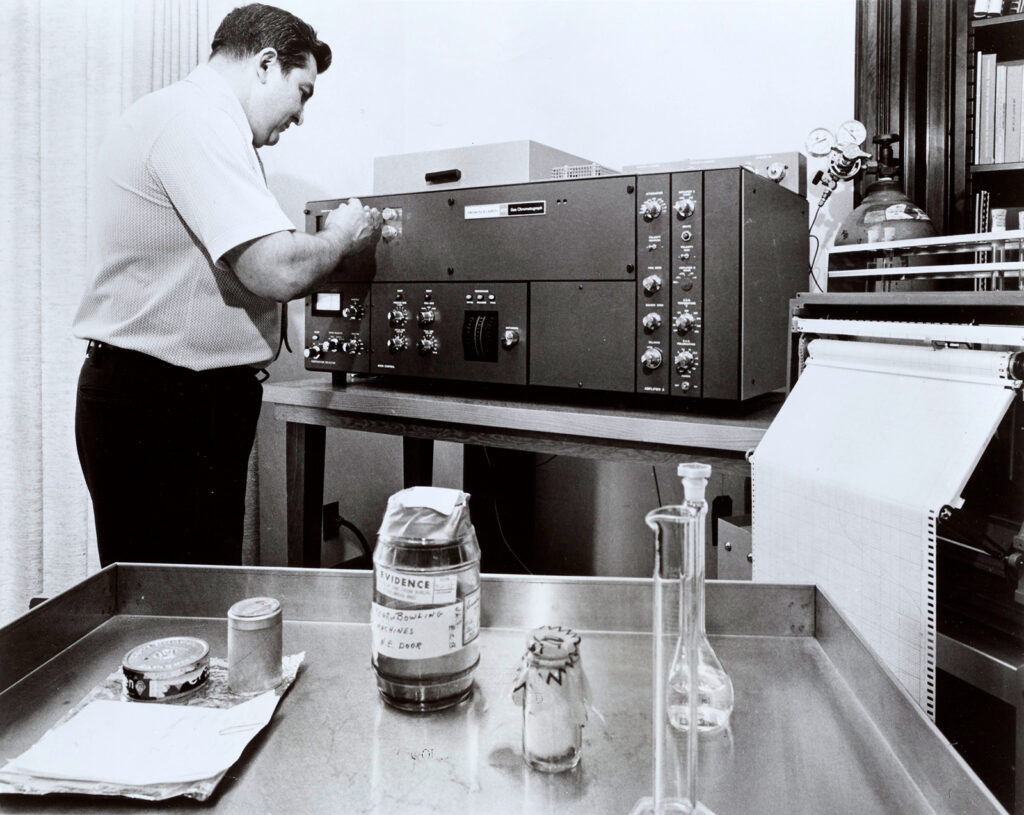
Dookhan’s colleagues were right to be suspicious. Although it’s not clear when exactly she started, Dookhan was committing fraud on a massive scale. Instead of actually running tests, she “dry-labbed” samples—simply glanced at them and guessed what they were. She got away with this because police officers usually submitted “control cards” alongside each sample, records that included their guess about the drug’s identity. Dookhan could therefore simply glance at the card and use that as her “analysis.” If the cops said it was heroin, it was heroin, and that was that.
Dookhan always tested unknown samples—those lacking control-card information—since she would have been guessing blindly. And she didn’t dry-lab everything; she tested roughly one-fifth of her samples, just to make sure. But otherwise she skipped the chemistry and rubber-stamped the police officers’ assumptions to keep her numbers high. Equally bad, she then signed certificates claiming she’d run the tests. Because these certificates served as evidence in courtroom trials, she essentially perjured herself over and over.
Even when Dookhan correctly guessed a drug’s identity, she violated the suspect’s right to due process. And unfortunately, she didn’t always guess correctly. Again, there were two rounds of testing at the lab, and different chemists usually conducted each step. If Dookhan went first, and the result of the second test contradicted her initial guess, a retest was conducted. But instead of admitting a mistake, Dookhan would sometimes sneak off, find a pure sample of the drug she had initially claimed, and submit that for retesting. Presto, the second test now gave the “correct” result. In other words, she started forging evidence to conceal her fraud.
Dookhan was committing fraud on a massive scale.
As a result, innocent people went to prison. One man was arrested with inositol, a white powder sold as a health supplement. Dookhan nailed him for cocaine. In another case, a man tried to pull a foolhardy scam and sell a small piece of a nut, claiming it was crack. The buyer turned out to be an undercover cop. Still, the suspect figured he’d go free: after all, it was just a nut. He then watched, stunned, as Dookhan swore in court to the contrary. “I knew she was lying” about running the tests, he later said. “Ain’t no way, no how, a cashew can turn into crack.”
Not everyone Dookhan lied about went to prison; low-level drug offenders often didn’t. But drug convictions have consequences beyond prison terms. You can get deported or fired or kicked out of public housing. You can lose your driver’s license or the right to see your children. And if you appear in court again, you’re now a repeat offender.
Dookhan’s reasons for doing all this have never been clear, but she did provide some hints. She sent state prosecutors earnest emails about getting bad guys “off the street.” She also seemed to adore the glory of being the top chemist in the lab: in another email to prosecutors, she bragged that “my colleagues call me ‘superwoman’ and say that I do too much for the lab and everyone else, in general.”
Regardless of her motives, it’s a sad fact that Dookhan was far from alone in her actions. In recent decades dozens of other forensic scientists, at labs around the world, have been exposed as cheats and imposters. To critics, in fact, Dookhan’s case only reinforced the notion that forensic science itself is something of a fraud.
In the early 1900s, police work was often subjective and arbitrary, if not outright abusive. In the rock-’em, sock-’em 1930s, for instance, cops would often coerce confessions by dunking suspects in water or dangling them out of windows by their feet. Forensic science arose as a rational, objective alternative to such methods, and by the mid-20th century the legitimacy of various subfields of forensics—arson investigation, firearm ballistics, fingerprints analysis, and so on—was firmly established in U.S. courts.
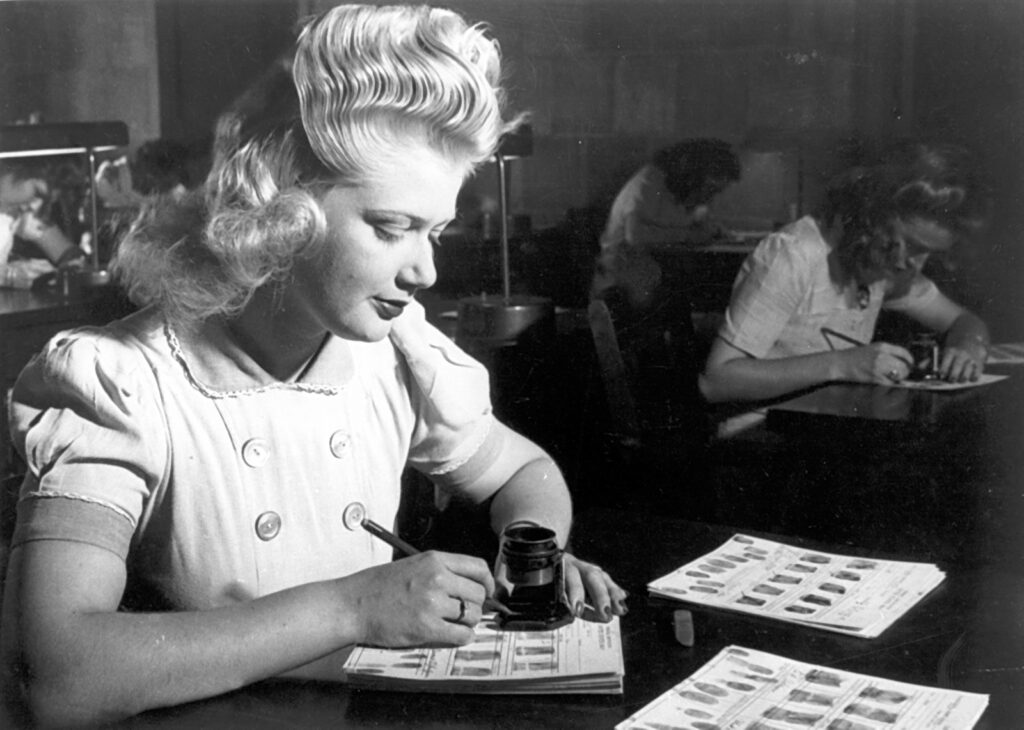
Unfortunately, much of what has passed for forensic “science” has been spotty at best and outright bunk at worst. In a damning report from 2009, the U.S. National Academy of Sciences outlined several glaring problems with forensic science—starting with the fact that most subfields lack any scientific basis. Some are merely collections of hunches gussied up in scientific jargon. As a result, different forensic experts often draw wildly different conclusions from the same sample. Worse still, a single expert sometimes draws different conclusions from the same sample at different times, depending on whether you mention beforehand that you think the suspect is guilty or innocent—evidence that bias drives the analysis.
Equally damning is the lack of uncertainty. Most published scientific research includes error bars and disclaimers about alternative explanations. In contrast, many forensic experts—especially when testifying in court—boast of zero uncertainty. On the witness stand, they claim they can match evidence, such as hair fibers or bite marks, to suspects with 100% accuracy and can do so 100% of the time. This aura of infallibility can then unduly influence jurors, in what’s sometimes called the CSI effect.
To be clear, not all forensic science is iffy. Toxicology and pathology are solid, and the National Academy report singled out DNA analysis as particularly trustworthy. Those fields have rigorous foundations and rely on well-grounded laboratory tests. But most forensic fields do not meet those basic guidelines.
Unfortunately, much of what has passed for forensic “science” has been spotty at best and outright bunk at worst.
Since the 2009 report, there are signs that the fields of fingerprint analysis and firearm ballistics have started to shore up their sloppy practices and shift toward scientific validity, largely through independent, data-driven studies that help quantify the methods’ reliability and accuracy. But problems continue to dog forensics overall. According to the Innocence Project, an advocacy group that scrutinizes evidence in court cases, “false or misleading forensic evidence” contributes to a quarter of all wrongful convictions in the United States, and some forensic disciplines have even poorer track records. One FBI study concluded that 90% of court cases involving microscopic hair samples included “erroneous” testimony.
So where does forensic drug analysis fit in? On the validity spectrum, it’s closer to the DNA side of things. Drug tests are reliable and repeatable, and if they’re performed properly, they’re a solid part of a criminal case. But the tests must be performed properly.
Dookhan’s downfall started with a whopper of a coincidence. In 2001 Boston police officers arrested a man named Luis Melendez-Diaz for dealing drugs outside a Kmart. Coincidentally, the police sent the baggies of cocaine they seized to the very lab where Dookhan would soon find a job. (By all accounts, these samples were processed properly; there were no hints of impropriety.) As was routine, the chemist in charge signed some court certificates, and this evidence helped convict Melendez-Diaz. All in all, a routine case.
Except Melendez-Diaz’s lawyers put forth a novel argument during the trial. The Sixth Amendment to the Constitution states that “the accused shall enjoy the right . . . to be confronted with the witnesses against him” in court. Traditionally, this meant eyewitnesses, people who had actually seen the crime committed. But Melendez-Diaz’s lawyers argued that forensic analysts should have to testify in person as well, rather than merely submit certificates.
After appeals, the case wound its way to the Supreme Court in 2009. In a five-to-four ruling, the court ruled in favor of Melendez-Diaz, meaning that scientific analysts now had to testify in court if called. (Surprisingly, Ruth Bader Ginsburg joined Antonin Scalia and Clarence Thomas in the majority.) In part, the majority ruled this way out of a concern for due process. The right to confront witnesses is essential to our notion of a fair trial, Scalia noted in his decision, and all analysts therefore had to appear in court even if they “possessed the scientific acumen of Mme. Curie and the veracity of Mother Teresa.” But Scalia also suspected that not everyone in the drug labs was a Madame Curie or Mother Teresa. Some analysts were probably incompetent or even liars, he mused, in which case the “crucible of cross-examination” would expose them. He might as well have had Annie Dookhan in mind when he penned his decision.
Many jurists objected to this ruling and did so on various grounds. First, the justices seemed to ignore or misunderstand the highly collaborative nature of contemporary science. It can take a dozen analysts to test a single DNA sample, and there’s no reason a defense attorney can’t call each and every one of them into court. Doing so would waste the analysts’ time—a major concern when unprocessed rape kits and drug samples might already sit waiting on shelves for months and when defendants must sit in custody awaiting trial that whole time.
Furthermore, many scientific tests are run by machines nowadays, leading one federal judge to mockingly wonder whether courts needed to start subpoenaing spectrographs and such in court. To be sure, opponents of Melendez-Diaz acknowledged that scientific results are sometimes dubious or fishy. But in those cases, they argued, the remedy was more science—sending samples to independent labs for additional tests.
Criticized or not, Melendez-Diaz became the law of the land in 2009. And the upshot is that forensic analysts such as Annie Dookhan have had to appear in court to testify on a regular basis.
So did the “crucible of cross-examination” expose Dookhan, as Scalia predicted? No. She kept right on lying on the stand. Dookhan testified 150 times in court, all under oath, and was never exposed for a single instance of wrongdoing while doing so.
Still, the requirement to testify did help expose Dookhan in a roundabout way. Every hour spent at the courthouse was an hour she couldn’t spend at her lab bench. As a result, her testing numbers plummeted. After the Melendez-Diaz ruling, she spent 92 hours testifying during the last six months of 2009 and got through “only” 6,321 samples that year. The numbers for other analysts dropped as well, to an average of roughly 2,000.
Did the “crucible of cross-examination” expose Dookhan, as Scalia predicted? No. She kept right on lying on the stand.
But while the other chemists’ numbers remained low the next year, Dookhan’s didn’t. She spent 202 hours testifying in court in 2010 but claimed to have churned through 10,933 samples—five times the lab average, and near her pre–Melendez-Diaz peak.
This was the point at which her fellow chemists really got suspicious. They began tracking Dookhan’s time at the microscope and snooping through her pile of discarded slides; their observations convinced them she was a fraud. Around this time, Dookhan also got caught skipping important calibration checks on different machines, presumably to save time. Worse, she forged a coworker’s initials on some paperwork to cover up the fact that she had skipped procedural steps.
Eventually a chemist reported Dookhan to his supervisor. To his frustration, the supervisor pooh-poohed him. Still, Dookhan now had official accusations against her. And a sloppy mistake finally exposed her for good.
The Boston lab had a walk-in evidence safe to store drugs awaiting testing, and there were strict protocols about signing samples in and out. Dookhan started taking samples without bothering to sign them out, a breach of chain-of-custody rules. She finally got caught one day in June 2011 with 90 unsigned samples. She then tried to cover up her blunder by, again, forging a coworker’s initials in a logbook. Unfortunately, the coworker hadn’t been at the lab on the day in question. When confronted with the logbook and asked if she had violated the rules, Dookhan got slippery, saying, “I can see why you would think that.”
Even then, Dookhan’s bosses didn’t punish her, although they did shift her to other duties. In December, however, the Massachusetts governor’s office got wind of the chain-of-custody breach and began investigating the lab’s procedures and practices. So many violations turned up that, in summer 2012, the state police felt compelled to seize control of the lab. Two days after the takeover, Dookhan’s fellow chemists spilled their suspicions about her to their new overseers.
Given the seriousness of the chain-of-custody violation, Dookhan had already resigned from the lab by the time state police took over. But she had yet to face any consequences for dry-labbing tens of thousands of samples—until two detectives knocked on her door in late August 2012.
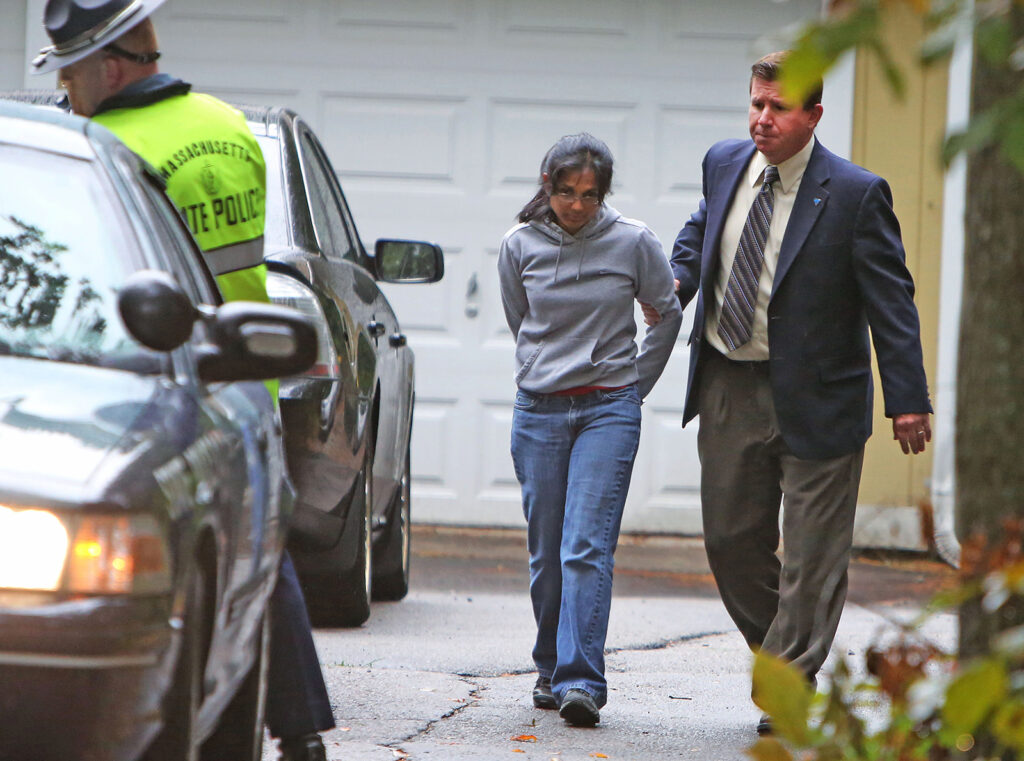
The detectives sat down with Dookhan in her living room and laid the forged logbook and calibration reports in front of her. When asked about them, Dookhan said, “I got the work done, but not properly. I didn’t follow the procedures, and that was wrong.” In other words, she admitted violating some technical rules but claimed that her science stood up.
In the middle of the interview Dookhan’s husband came home and pulled her into another room. He asked her if she needed a lawyer; she assured him everything was fine.
When the detectives asked her whether she’d ever dry-labbed, Dookhan denied it: “I would never falsify, because it’s someone’s life on the line.” The detectives responded with more evidence.
As mentioned, Dookhan would sometimes guess that a drug was, say, cocaine, only for a subsequent machine test to find heroin or another substance. In that case she would sneak some cocaine from a different sample and resubmit it for more testing to “confirm” her first claim. But the detectives had dug up the original samples from several of Dookhan’s cases with initially conflicting test results. The detectives had the samples retested and determined that Dookhan’s assessments in these instances were wrong. It was damning proof that she’d forged the results.
Despite this evidence, Dookhan still tried to downplay her fraud, insisting that she’d dry-labbed only a few times. When the detectives pressed further, she finally broke down. “I messed up,” she said. “I messed up bad.”
Dookhan eventually pleaded guilty to 27 counts of perjury, tampering with evidence, and obstruction of justice. Her confession also plunged the Massachusetts legal system into chaos. Because Dookhan couldn’t document which samples she had dry-labbed and which she had actually tested, all of the roughly 36,000 cases she had worked on during her career were now suspect. The state legislature had to allocate $30 million to deal with the fallout; one legal advocacy group estimated it would take 16 paralegals a full year of work just to notify all the affected people. Appeals flooded in, and Massachusetts courts eventually overturned 21,587 convictions, the largest such action in U.S. history.
Meanwhile, Dookhan got sentenced to three to five years in prison in November 2013. For comparison, trafficking a single ounce of heroin at that time carried a sentence of seven years. Considering the scale of her misdeeds, the paltriness of the sentence frustrated many. “You walk away feeling this is really inadequate,” a state legislator said. Indeed, Dookhan didn’t even serve three years, walking out of prison a free woman in April 2016.
Annie Dookhan is hardly the only forensic scientist to be busted for wrongdoing. In the past 20 years similar scandals have erupted in Florida, Minnesota, Montana, New Jersey, New York, North Carolina, Oklahoma, Oregon, South Carolina, Texas, and West Virginia. Sadly, the string of incidents includes the distortion or withholding of forensic evidence in at least three capital cases.
Incompetence has been an ongoing issue as well. Crime labs have been caught leaving evidence under leaky roofs or in unsecured hallways. One lab was run by a police officer with no scientific background and employed analysts who would consult Wikipedia for technical details.
Massachusetts courts eventually overturned 21,587 convictions, the largest such action in U.S. history.
Agonizingly, Massachusetts got burned a second time shortly after Dookhan’s arrest. A chemist in the state’s Amherst drug lab was caught dipping into samples of meth, cocaine, ketamine, and ecstasy at work and getting high while running tests. She also admitted to getting high before testifying in court.
Dookhan’s fraud nevertheless stands out for its audacity and scope. In some ways it’s hard to believe she got away with her crimes for so long. But in other ways, perhaps it’s no surprise at all. No matter how you slice it, scientific fraud isn’t rare. Hundreds of scientific papers get retracted every year, and while firm numbers are elusive, something like half of them are retracted due to fraud or other misconduct. This erodes public trust and damages science’s greatest asset—its reputation. In forensic science the stakes are even higher, given that misdeeds there can ruin people’s lives.
Forensic science may have begun as a reform-minded alternative to the abusive and arbitrary police work that preceded it, but as the Annie Dookhan case and other scandals show, it’s got a long way to go to reach that ideal.

